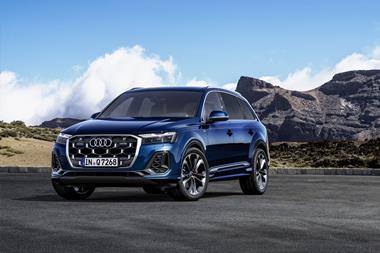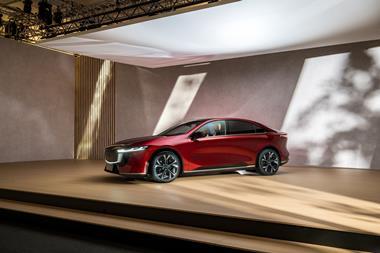The automotive industry outlook is rapidly evolving and OEMs, tier suppliers and logistic providers alike are all having to swiftly adapt to rapidly changing regional market dynamics. Mike Wall, executive director, automotive analysis, S&P Global Mobility provides his expert insight at this year’s Automotive Logistics and Supply Chain Global conference.
Key takeaways
- Global economy has avoided recession, but global and US growth is expected to cool slightly.
- Automotive sales growth is slowing in the top 10 global markets, but with regional variation.
- 2023 was an inventory rebuild year, with 2024 production falling but slowly increasing by 2030.
- China has rapidly become a net exporter, primarily to Mexico for low-cost ICE and Europe for EVs.
- Europe was a net exporter but has become a net importer, mainly due to declining Chinese sales.
- US vehicle sales are growing but have not recovered to pre-Covid volumes due to affordability.
- BEV forecasts substantially revised down due to the ‘trough of disillusionment’ hype-cycle phase.
- ‘Multi-energy’ production lines will become the most common to hedge against EV uncertainty.
- China currently leads EV adoption, but the US and Europe are expected to catch up by 2030-2035.
- US election in November underpins the outlook particularly for EV forecasts and total volumes.
Attendees at the Automotive Logistics and Supply Chain Global 2024 conference in Dearborn, Michigan, US received a thorough and insightful presentation from Mike Wall, executive director, automotive analysis, S&P Global Mobility who comprehensively examined the market drivers, disruptors and opportunities.
Macroeconomic growth outlook
Wall’s session began by setting the scene and laying out the broad macroeconomic themes underpinning vehicle demand and influencing industrial and economic development, such as GDP, inflation, interest rates, unemployment and consumer sentiment.
He provided historical context, stating emphatically: “The recession of 2023 that was going to be upon us throughout the year never materialised.” While that threat has not gone away completely, that outlook seems to have eased for now. Wall added: “We’re looking at global growth of about 2.7% this year globally, and in the US about 2.6%.” The storm clouds, for the time being, have held off, with the Federal Reserve recently cutting interest rates signalling further reductions.
However, Wall cautioned that this positive outlook may not persist in the medium term: “We do start to see those growth rates, especially in the US, start to cool a bit further.”
Automotive sales growth is slowing
The outlook for automotive sales is mixed, driven by two competing trends. “If you aggregate the top ten markets, we’re up about 2% year to date. That’s the good news,” Wall noted.
However, he tempered this optimism: “The bad news is it is slower growth… Last year, globally, we were up about 10%. So we’re taking a step down in growth.”
Regional variation also contributes to the mixed global picture. For example, Wall observed: “If you look at China, sales were up about 2% earlier in the year, but what we’ve seen is more choppy waters in China. China demand has gotten weaker.” Despite the Chinese government trying to stimulate overall demand with a range of by incentives such as the scrappage scheme, these mainly boosted electric and hybrid vehicle sales, rather than overall sales.
Similarly to China, there is evidence of slowing sales growth in the US, and we’re up about 2% from a year earlier. Growth is positive, but as Wall reflected: “It’s better to be up than down, but it’s coming in a little bit below our expectations. This has cascaded out through some of the other major markets around the world too.”
Production and capacity utilisation
The other part of the picture is the production and the corresponding capacity utilisation rates. Wall observed: “It’s important, the throughput portion, because it’s important to understand we’ve improved our capacity utilisation from the depths of Covid. That’s a low bar, though, frankly.”
Read more: Mike Wall’s view on US-Mexico trade following US election results
It has been well documented that throughout Covid, capacity utilisation rates fell below 65% in North America and Europe. However, OEMs managed to remain profitable due to the supply-constrained market where they could prioritise high margin vehicles and command above sticker prices for vehicles.

As production constraints have eased, we are now in a demand-constrained market, where prices and margins are being squeezed. This era of low profitability places greater pressure on improving capacity utilisation rates.
Whilst capacity utilisation rates have recovered since Covid, especially in China (85%), Japan, and South Korea (80%) during 2024, Wall cautioned: “There are some warning signs on capacity and capacity utilisation that we’re going to have to be mindful of.” For example, capacity utilisation rates are expected to be 72% in North America and 77% in Europe, reflecting a 2% decline in both regions compared to 2023. This decline is attributed to slowing sales demand in those areas.
Global light vehicle production and sales
The year 2023 was pivotal for vehicle production, reaching 90.5 million units, and globally, production is back at pre-Covid levels (89.0 million units in 2019). This is significant because, although sales demand hasn’t quite rebounded to pre-Covid levels yet, it has resulted in excess production. Consequently, 2023 has largely been an inventory rebuild year to recover depleted levels from the Covid period. Wall concluded: “This is going to be very much more of a kind of a reset year, a digestion year of that production that we did last year.” Overall, production levels for 2024 are forecast to fall slightly to 88.5 million units.
As production and sales return to equilibrium, a steady, gradual growth in production is expected, “culminating closer to that 98 million units figure (by 2031),” which aligns with the sales forecast.
However, the global outlook will diverge, presenting two distinct streams of growth. One of the consequences of growing globalisation, reshoring and localisation is that, unlike in the past, regional production and sales demand are increasingly aligning. Wall noted: “Markets with strong growth prospects from a demand perspective are seeing similar production growth. We see this in greater China, rest of world, South Asia again, India and those ASEAN markets, where vehicle density remains low.” From a production standpoint, and by extension from a logistics and supply chain perspective, this is a significant factor for medium- to long-term strategic planning.
In contrast, to that rapid emerging market growth, “developed markets like North America, Europe to a great extent, especially Western Europe, are in a different place from that perspective,” Wall commented.
China light vehicle production
Until recently, Chinese vehicle production largely catered to domestic demand and was not known for exports. However, since around 2017, China has begun to export increasingly large volumes. Wall observed: “Last year we were at 2.5 million units of vehicle exports out of China. This year will probably be about 3.1 million. We see that growing to probably 3.6 to 3.7 million, even in the face of some of the stiffer tariffs that we see out there.”
These exports follow two broad flows. “You’ve got low-cost internal combustion engine (ICE) vehicles that are being shipped out of China to other markets like Mexico, and other emerging markets, and you’ve got low-cost battery electric vehicle products going to Western Europe and other regions as well.”
This change in production reflects a fundamentally changing dynamic within China. “It’s really a testament to the growth and resurgence of the domestic brands within China,” Wall explained. The primary domestic brands include BYD, Chery and Great Wall.
A profound shift has occurred as foreign joint ventures, such as VW, Ford and GM, were previously the major players partnering with domestic manufacturers. Wall illustrated this change: “In 2019, foreign OEM share of production in China was about 53%. That is eroding under our very feet as we sit here. This year, it will be in the low 40%, of foreign automaker operations in China or production in China, falling closer to around 30% as you get towards the tail end of our forecast horizon.”
This decline is due to that fact that, unlike in the past, Chinese-produced vehicles have caught up in quality and, in many cases, have surpassed Western brands offerings. Chinese vehicles are now considered better value, having better software integration and infotainment systems than Western brands.
Europe light vehicle production
Part of the seismic shift in Europe’s manufacturing is evidenced by recent developments such as VW’s threatened plant closures in response to changing market realities. Wall confirmed this by revealing the longer-term trend: “Europe was a net export market, meaning they exported more than they imported as whole. They exported a very sizable chunk of that production to other markets. Now they have become a net import market.”
This shift is attributable to three main reasons: First, the impact of Chinese imports gradually penetrating into Europe. Second, to reduce production costs, German and other European OEMs are increasingly shifting manufacturing to other plants in the US and China, and in some cases, even re-importing some of those vehicles back to Europe. The third factor is the shift towards electrification and away from unprofitable entry-level vehicles. Wall elaborated on the implications: “A lot of automakers are exiting those segments because they can’t build those vehicles profitably or be able to hit those emissions targets with either a petrol or diesel vehicle. And they’re not quite ready for prime time in terms of delivering cost-effective battery electric vehicles (BEVs) to the market.”
US light vehicle sales
For US light vehicle sales, the pre-Covid high was 17.1 million units in 2019. Since then, US vehicle sales have struggled to recover to those pre-pandemic volumes. Wall noted: “During that period, we’ve gone through this sort of ‘W’ shaped recovery.” In 2023, US vehicle sales reached about 15.6 million units, with current expectations for 2024 at 15.9 million units.
The primary reason for this sluggish recovery is vehicle affordability. Wall remarked: “We’ve seen a bit of a slowdown in demand. The realities of affordability, I think, are finally being reckoned with within the industry.”
However, affordability is not just about interest rates – though these are heading downwards. The bigger picture reveals that average vehicle prices in the US have increased by 32%, from $33,600 in Q1 2018 to $44,700 in Q1 of 2024. This increase is reflected in the average auto monthly payment, which stands at $730-$740, compared to $550 pre-Covid. This shift is partly explained by product mix, as OEMs are pulling out of low-margin entry-level vehicles that previously drove volumes, opting instead to produce more expensive, higher-margin pick-up trucks and SUVs.
US vehicle inventory rebuild
Pre-Covid, the US had around 3.5 to 4 million units of inventory, but this plummeted to about 1 million due to supply chain shortages. However, due to a surge in 2023 production, the US has built back inventory, with Wall stating, “we’re probably at about 2.7 million units of inventory now, and we don’t see the market getting back to 3.5 to 4 million.” This is primarily because that 2.5 to 4 million is predicated upon on a 17 million unit selling base, while actual sales are closer to 16 million units.
Nonetheless, challenges remain in managing inventory for all OEMs. Wall remarked: “The Detroit three certainly are wrestling with it in varying degrees, and even some of the other foreign automakers operating here as well, with this inventory challenge.”
North America light vehicle production
North American light vehicle production volumes in 2023 stood at 15.7 million units. However, in 2024, “reflective of the fact we got to burn off some of this inventory, we’re at 15.5 million,” Wall commented. For 2025, the prediction is now at 15.4 million, with forecasts remaining relatively flat for the rest of the forecast period to 2031. Two main factors contribute to this outlook: The ongoing inventory rundown and likely vehicle timing changes, with delays in electric vehicle (EV) programme ramp-ups and extensions of ICE production.
North America light vehicle product launches
In North American, product launches are expected to reach 38 in 2024, falling to 25 in 2025 and rebounding to 31 in 2026, peaking again in 2027 with 43 launches, particularly for EVs. These delayed and deferred product launches are intentional; many programmes are being delayed to an unprecedented degree. Wall stated: “I’ve been in this industry 25 years. It’s not uncommon to see a vehicle delayed six months, maybe a year. We’re seeing vehicle programmes delayed two years, three years.” This volatility and uncertainty are having a knock-on effect for suppliers throughout the automotive value chain.
The quest to accelerate BEVs
Despite current media reports suggested that the EV transition is faltering, global EV sales are still increasing, albeit with significant regional variations. Wall explained: “In China, we’re at about 29% adoption of electric battery vehicles. In the US, we’re at about 8%, while in Europe, it varies widely; it might be in the mid-teens or high single digits.”
Wall framed this EV transition within the context of the Gartner hype cycle, explaining that especially in the US, we’ve got a lot of early adopters who are very happy with the purchase, but now experiencing a “trough of disillusionment” as it seeks to achieve mass market adoption. The situation explains the influx of new BEV models targeting the compact to mid-sized electric SUV market. However, consumer disillusionment persists, stemming from concerns about charging infrastructure, battery durability and range anxiety.
Deflating the BEV hype bubble
From an industry perspective, there has been a notable shift in consumer interest in BEVs. Wall observed: “Towards the tail end of last year there was a palpable shift in sentiment or intention on the part of the automakers as it relates to BEV. Those fully committed to BEVs remain steadfast, but we are witnessing real delays in the full-scale launch of some of these vehicles.”
As a consequence, S&P Global has substantially revised its BEV forecasts. “We’ve pulled about 6 million units of BEV production out of our forecast. Now, I’ll be the first to say we did not lower the North American production by 6.2 million units across that time frame. It’s being offset, offset by ICE, longer and fatter tail on ICE, and offset by hybrid activity as well.”
North America battery electric vehicle production, model count and nameplates
The forecast for BEV model count indicates that in 2023, there were about 36 models, projected to grow to 153 models by 2030, equating to an expected production volume of 7 million units by that year.
However, Wall noted: “In terms of battery electric, the volume per nameplate is particularly interesting for suppliers. The average ICE vehicle has a volume per nameplate of 85,000 to 90,000 units per year. In 2019, we were at almost 70,000 units for BEVs.” Admittedly, a large part of that volume is driven by Tesla, but that volume per nameplate for other brands goes down to 30 to 35,000 units per year per nameplate. This disparity could have big implications in the supply chain, particularly for high-volume manufacturers. Wall rhetorically asked: “How do we mitigate against this for inbound logistics providers in terms of truckload and fill rates?”
North America light vehicle production capacity by propulsion type
Wall expressed concern that a capacity bubble may be developing in North America. The automotive industry has historically been characterised by varying degrees of overcapacity, which is almost inevitable to some extent.
The propulsion type of that production capacity is now increasingly important. With North American production capacity expected to reach 25 million units by 2030, the fastest growing production capacity will not be ICE or EV, but ‘multi-energy’ vehicles. Wall described this as, “the ultimate hedge”.
“It can produce ICE, BEV or hybrid. As we phase out ICE capacity, we need to backfill it with multi-energy production to keep operations viable. This, combined with the addition of BEV-only capacity, is creating a capacity bubble to the tune of about a 60% to 62% utilisation rates in the intermediate to longer term. That’s tough.”
Optimising and managing that potential overcapacity during the EV transition is fundamentally going to be the challenge for the OEMs and tier suppliers alike over the next decade, whilst also being flexible enough to respond with agility to the inevitable fluctuations in consumer demand by propulsion type on what now appears to be a non-linear journey to full electrification.

Light vehicle electrification trends by region
Current EV adoption rates reveal a clear leader in mainland China, where EVs account for 24% of the market. Europe follows with 15%, while the US lags behind at 9%. Industry consensus suggests that China is rapidly accelerating EV adoption, while some Western markets, notably Germany, are stagnating or even reversing course.
However, the data challenges this assumption. Recent reports indicate that global EV sales will reach record volumes in 2024. Moreover, S&P Global Mobility’s forecast also confirms this view and predicts EV growth in 2025 and substantial growth further ahead for 2030 and 2035.
Interestingly, S&P Global Mobility forecast that this industry transformation will not be led by China as previously assumed, but other regional EV adoption rates will rapidly catch up with mainland China with the US predicted to reach 40% EVs in 2030, and 63% in 2035. Wall admitted: “By 2030, we’ve got it at 40%. Now, that’s a markdown - we were previously at closer to 50% - but we started to scale some of that back. We’ve seen some adjustments on the Federal emissions front. We’ve seen some, certainly some correction as it relates to the consumer adoption side.”
For Europe, S&P Global Mobility forecasts EVs reaching 54% in 2030 and 84% in 2035 – in large part due to strict European climate change policies. “We’ve got a lot of emissions regulations coming on in Europe,” Wall elaborated: “The ‘Fit for 55’ programme meaning a 55% reduction in CO2 emissions by 2030 and 100% reduction by 2035.”
US Election scenarios
The political landscape is critical to these forecasts, particularly the US elections in November 2024. The ideology divide over automotive emissions and CO2 targets could influence the future of EV adoption. S&P Global Mobility has developed four key scenarios. Wall highlighted two of particular interest: “The BEV rate of adoption could differ sharply depending on the election outcome. We’re currently at about 29% in a Republican White House (with a split House and Senate). We might be seeing that closer to 35% even in a Democrat White House with a split Congress, though maybe closer to 35% instead of that 40% that we’ve currently got earmarked.”
Perhaps even more importantly, Wall emphasised the potential effect of EV penetration rates on total industry volume figures: “In scenarios where BEV adoption is scaled back, we might see a lift in total vehicle sales, as segments that have been cut due to profitability concerns or emissions regulations could return. This could boost sales by 2% to 6%, depending on the scenario.”
For further insight into the automotive logistics market, explore the latest series of business intelligence reports from Automotive Logistics:
These reports provide critical analysis and forecasts to help leaders stay ahead in this evolving industry.








































No comments yet